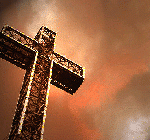Three Churches
“Step by step, we’ll make the journey, even though our way seems hard, hard, hard
Step by step, we’ll make the journey, but we must put our trust in God “
~Song choir members sang as they marched into Park Avenue Baptist Church
Faith, Our Rock in the Wind

- Allen Chapel A.M.E.Church, by Shermella Garrett-Egson
- Park Avenue Baptist Church, by Louise B. Key
- Second Baptist Church, Historical Papers
Black Churches in the Western Canaan
By Vince Moses
Excerpts Used with permission
The first two African American churches in Riverside were the Second Baptist Church (1890) and Allen Chapel, African Methodist Episcopal Church (1875).
Some of the early members of the Second Baptist Church originally belonged to First Baptist Church, one of the influential Anglo churches in Riverside. The Charter of Incorporation of the Church was filed on March 10, 1900. Early members included such pioneer families as Stokes, Decatur, Edwards, Henderson, Bryant, and Carter. The first pastor was the Rev. John Clisby from Tampa, Florida, followed by the Rev. Joseph Whitlock.
Allen Chapel (A.M.E.) was organized on Seventh Street in the home of Mrs. Dobbs, and one of the Charter Members was Walter Williams. Three early members of Allen Chapel were Mr. and Mrs. John Henry Brown and thier daughter, Norine Gordon. Norine Gordon formally converted to Christianity in Allen Chapel in 1901, and married there in 1907.
Park Avenue Baptist Church formed in 1915 as a result of disagreement within the Second Baptist Church – the first evidence of splits with the “old family” established social and religious structure of African American Riverside. During the pastorate of Rev. Frank K. White, fourteen members of the Second Baptist Church led the break with Second Baptist. These fourteen, who were rapidly followed by twenty-six others, became the nucleus of Park Avenue Baptist Church. John and Eva Allen held the first meeting at their home, and the Church was formally recognized in December, 1915 by a council composed of Dr. J.D. Gordon, F.W. Cooper, W.H. Rozier, and others
A number of the members of Park Avenue Baptist Church came to Riverside after 1900. Those most active in both African American and Anglo community affairs, and those who first challenged the Anglo power structure of Riverside, were founding members of Park Avenue Baptist Church, and among those who arrived after 1900.